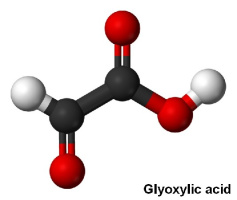Glyoxylic acid
Synonimes:Glyoxylic acid, Oxo Acetic acid, GA
CAS: 298-12-4

PROPERTIES
Glyoxylic acid (GA) is a colourless solid that occurs naturally and is useful industrially. Aqueous solution of Glyoxylic acid is transparent colorless or light yellow liquid. Soluble in water and ethanol, slightly soluble in organic solvents like ether or benzene, insoluble in esters aromatic solvents. This solution is not stable but will not decay in the air.
GA is a strong organic acid and a highly reactive chemical intermediate having two functional groups: the aldehyde group and the carboxylic acid group. Because of its bi-functionality is a versatile reagent in organic and fine chemicals syntheses.
APPLICATIONS
ELECTROLESS COPPER PLATING
REDUCTOR
Glyoxylic acid as an alternative reducing agent for electroless copper plating was investigated. Plating rates and bath stability were superior to that of the formaldehyde bath under standard conditions. Glyoxylate ions in the plating bath have no vapor pressure and showed good reducing power in the electroless copper plating. Therefore, glyoxylic acid can replace formaldehyde, and eliminate health and environmental problems resulting from generation of the fumes (research overview).
HISTOLOGY
BIOGENIC AMINES VIZUALIZER
The glyoxylic acid condensation reaction is commonly used for visual detection of biogenic amines in histological sections. This is the sucrose-phosphate-glyoxylic acid (SPG) histofluorescence method for the visualization of monoamines in tissues where the fluorescence is analyzed by fluorescence microscopy. It is used for counterstaining tissues.
ENVIRONMENT
There is possible to synthetize amino acids from GA by oil – bearing plants.
FUNGICIDES
The glyoxilic acid derivatives were discoverd as a new class of Oomycete fungicides. The GA derivatives exhibit specific activity against oomycetes, including dwony mildew on grapes (Plasmopara viticola) and late blight on potatoes an tomatoes (Phytophthora infestans). They are active against Oomycetes in soil such as Phytophthora in tabacoo and citrus. They exhibit protective, curative, eradicative and antisporulant activity. This class of compounds can be synthesized wih a simple synthetic approach where in the second step the glycolic acid ester is needed.
WOOD
CATALYST
There is formaldehyde-free aminoresin wood adhesives based on dimethoxyethanal (DME).
Its precursors prepared by the addition of DME to melamine or urea gave resins for boards that were able to harden. Melamine and urea reacts with one and two (melamine up to three) molecules of DME to form M-DME and U-DME (called DU), and the subsequent cross-linking reaction to form bridges occurs when the reaction is catalyzed during resin preparation by the addition of glyoxylic acid. That has allowed the formation of different oligomers formed by both aldol condensation and condensation of melamine and glyoxylic acid with two molecules of melamine to form dimers.
More examples of applications for glyoxylic acid derivatives:
PHARMACEUTICALS
Acryloamidoglycolic acid in polymer chemicals and D,L-p-hydroxyphenylglycine, D,L-p-hydroxyphenylhydantoin, orotic aid, sulindac, mandelic acid, p-hydroxyphenylacetic acid, diphenylacetic acid.
AGROCHEMICALS
Ethylene bis(hydroxyphenyl)glycine, PYRIDATE, glyphosate, 2-hydroxy quinoxaline.
FLAVOR AND FRAGRANCE PRODUCTS
Aroma chemicals such as vanillin, ethyl vanillin, heliotropin.
PERSONAL CARE INGREDIENTS
Allantoin. The diureide of glyoxylic acid which is active in skin-softening (keratolytic effect) and rapid cell regeneration by precipitating proteins on skin.
Other uses:
Material for water purificant, used in the preservation of food.
Crosslinking agent of polymerization and plating additive.
Starting material for the synthesis of iron chelates.
Intermediate of varnish material, dyes.
| CAS | Name of article | Recent inventory | Package unit | Request offer |
| 298-12-4 | Glyoxylic acid | 150.00 kg | opened drum |
Kat-Chem Kft.
Székhely
Beckó utca 23-25.
H-1149
Budapest
Iroda
Huszt u. 24.
H-1147
Budapest
Telefon: +3612219945, +3613630194
Fax: +3613835784
E-mail: kat-chem@kat-chem.hu
